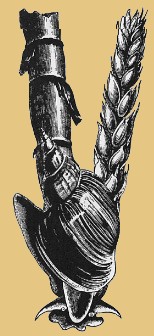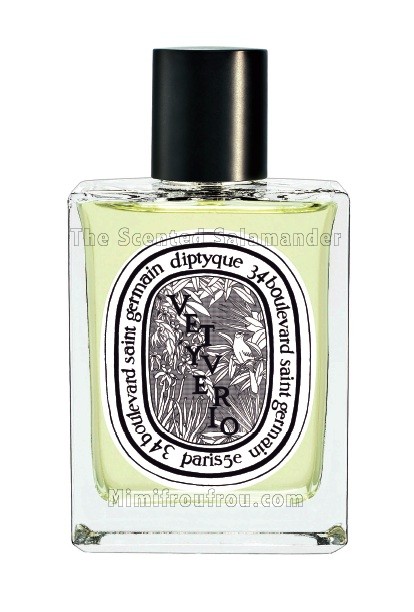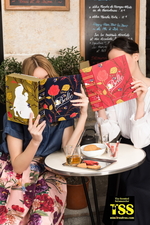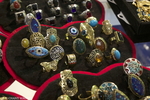Diptyque Vétyverio (2010) & Guerlain Vétiver pour Elle (2007): Looking Back at Niche Perfumery & Guessing the Sex of Vetiver {Perfume Review & Musings} + 5 Samples Draw
Diptyque, The First Modern Niche Perfume House in France

Vetyverio is the latest opus by Diptyque, the first modern niche fragrance house with L'Eau in 1968. People usually assume that French niche perfumery was born in 1976 with L'Artisan Parfumeur, but in the 1960s in Paris there was already Diptyque.
They invented the culture of niche scent, with this original meaning of offering confidential and unusual perfumes which are not known by the wider public but whose existence becomes impossible to ignore among connoisseurs.
It so happens, maybe not coincidentally due to their pionneering spirit, that the Diptyque boutique tucked away on a quiet stretch of the Boulevard Saint-Germain, not far off Place Maubert, came to represent my first-time entry-point into this universe of half-hidden scents, whose existence you learn of by word of mouth. That was of course before the Internet and the advent of blogs.
L'Autre by Diptyque (1973) was my first Diptyque perfume love and purchase, smelt initially on a friend of the family. It exhibited a forceful signature and a very assertive style of perfumery, which immediately felt like an OVNI, i.e., different. I decided I had to go to the brand's flagship store in a sort of pilgrimage.
Diptyque was founded as early as in 1961 but initially sold textiles and wallpaper, then home decoration before turning to scented candles in 1963. They launched their debut fragrance in 1968 called L'Eau. Many Diptyque fragrances from the early days are signed by perfumer Serge Kalouguine who also worked later on for the Laura Tonatto perfume house and is attached to Fragonard in Grasse...
It is a testament to Diptyque's anti-conformism and sense of style, i.e., non-trendiness and timelessness that in the midst of Mai 68's social upheavals in Paris and France, the brand put out a perfume reportedly inspired by the medieval ages (I recall the mention of an Elizabethan recipe before); you were invited to bring a pomander to your nose to put some distance between you and the students' upheaval in Paris, or the swinging 60s in London.
Diptyque has, I realize better now, significantly contributed to shaping the phenomenon of purist niche perfumery as we know it today and its taste for off-the-beaten-track, more difficult accords. Dry, austere and spicy notes with a neutral sexual gender were my first olfactory introductions to this world.
It ironically turns out that new is never completely new as the house itself took its original inspiration from reviving ancient recipes (L'Eau) and turning to a very historicized Old-World: L'Autre for instance is inspired by a spice market in Damascus; and L'Eau Lente is an impression of slow-burning incense on braseros in the times of Alexander the Great.
8 years before L'Artisan Parfumeur est. 1978, 12 years before Annick Goutal est. 1980, and long before Maître Parfumeur et Gantier and Parfums de Nicolaï, which both came to be established in 1989, there was for amateurs of rarer aromatic concoctions a reference point in France and Paris in particular: Diptyque.
Serge Lutens Est. 2000 would later on bring his own creativity and vision to this world by introducing the strong and believable persona of the olfactory artistic director (although Dyptique's Desmond Leet-Knox was one noted one already), as well as making the representation of the olfactory aesthet gel. But it all started very quietly, discreetly, yet convincingly 32 years earlier at least.
Even though there were old confidential perfumeries such as Penhaligon's and Creed (not to mention "niche" perfumeries in Italy: old ones - Santa Maria Novella est. 1622 - and new ones - I Profumi di Firenze est. 1966), Diptyque brought a cachet of artistry, connoisseurship and creativity to this field, as well as a culture of singularity.
Annick le Guérer interestingly reports that before selling their own creations the Diptyque boutique carried Floris and Penhaligon's perfumes as part of their offerings, which points to a line of influence. Elizabeth de Feydeau has written a monography about the candle and perfume house which I have not yet read, but managed to get one of the last remaining copies - I look forward to reading it.
The Story of Vetyverio: Inspiration and Ingredients
Diptyque's new vetiver addition to their collection, Vetyverio, is said to have been done in the same "Asian vein" as Tam Dao.
A resolute effort was made for Vetyverio to play up the natural ingredients so that fewer synthetic materials would be needed. To wit, the vetiver accord which rests on two types of vetiver, one from Indonesia described as rough and earthy and the vetiver from Haiti, more subtle and delicate was "nearly overdosed" and this heightened push from the "naturals" made it possible to forsake the help of supporting synthetics to intensify the accord. Both vetivers were steam-distilled and fractioned making up 25% of the formulation.
The floral facet rests on a bio-certified grade of ylang ylang from Madagascar which was noted for its interesting hard-candy note to it. There is also an absolute of Turkish roses and a slightly peppery geranium from Egypt.
The top notes are fruity, citrusy and seen as gourmand by Diptyque: Italian mandarin, Florida grapefruit, lemon and bergamot from Sicily.
Gender Theory & Leanings
Vetyverio is given as a floral vetiver. It is interested in invoking gender differenciations while negating them at the same time. Niche perfumes are theoretically supposed to be indifferent to gender demarcations so the need to express a position on this topic may be seen as a communication effort to speak to social conformism while upsetting it. The main balancing concept for the fragrance was to ally a reportedly quintessential masculine note, vetiver, with a floral bouquet usually seen as feminine. We can note that instead of feeling they helped break the mold, Diptyque is only too aware of common gender categorizations but tries once more to redefine boundaries creatively. Indeed, the first great vetiver fragrances were masculine: Vétiver de Carven (1957) which inspired the two others: Vétyver de Givenchy (1959) and Vétiver de Guerlain (1959). Both Hubert de Givenchy and Jean-Paul Guerlain have mentioned the Carven vetiver as one to emulate. Of course, we will have to take a sniff at Guerlain Vétiver pour Elle (2004/2007), also a floral vetiver interested in a gender redefining of the material vetiver as well. What Diptyque says is that
"One should not expect a classical style of perfumery writing. Vétyvério is neither in the masculine nor the feminine. Or else it is both at the same time. For Dyptique who does not like preconceived notions, plays with messing up genders [...] Man assuredly is not a beast nor woman, fortunately, a doll."
The sweet facet of Vétyvério opens up for me a social interpretation too: is this gourmand leaning meant to be an unisex, universal binding accord or is it open to the idea that women often are associated with sweetness more than men in the food culture, right after children? For instance, women are supposed to enjoy sweet wines and alcohol more, what one calls "liqueurs de dames." Sweet perfumes are generally thought to be feminine ones.
As I am smelling the long drydown of Vetyverio for the umptieth time, I become aware of an "addictive" skin scent note which I also see as an effort to speak to a more majoritarian taste. For someone who started with scents like L'Autre, there seems to be a historical shortcut here taken between the original Diptyque drydown of spicy, cumin-y musky sweat and this 21st century Diptyque concession to a more modern, cleaner gourmand-sexy taste. It's not Ricci Ricci, but it's sweet and gustatory.
How it Smells
Vétyvério opens on an ambery sweet and fruity-citrusy impression soon followed by the characteristic scent of vetiver which here takes on a nutty, hazelnut cast with more than a trace of condensed milk, especially on ulterior readings of the scent. It is very nearly gourmand calling to mind fragrances by L'Artisan Parfumeur like Bois Farine with its hint of peanut butter spread and Poivre Piquant (2002) with its notes of honey, milk and black pepper. I am also reminded of the soft white lactic impression from Zadig et Voltaire Tome 1 La Pureté, a "patchoulait." Here it would be a "vetiverolait."
But there is also a floral veil sensation adding a more evanescent touch to the perfume. I realize after a while that this floral facet is not unlike the one found in L'Homme by Yves Saint Laurent which makes it in my book (and not only mine apparently) an ambiguous masculine scent easily borrowable by women.
After this opening which rings of familiar gourmand echoes and betrays a certain penchant for milky sensations which I have come to call the Milka perfume genre, Vetyverio takes on some more fresh eau-de-cologne accents which remain subtle and tie in with Diptyque's efforts at renewing the genre in the past few years with the issue of four cologne-inspired scents all done by the creator of this fragrance perfumer Olivier Pescheux: L'Eau de L'Eau; L'Eau des Hespérides; L'Eau de Néroli; L'Eau de Tarocco. In this passage, the jus becomes more its own person with the juxtaposition of the nearly creamy texture of vetiver with a fresh eau de cologne coolness.
As the scent progresses, the sweet, edible treatment of vetiver never leaves the scene but drier and woodier accents warm up the composition with feels understatedly hot as in spicy, but also hot as in a Sirocco wind blowing over the desert. The latter sensation reminds me of the parched heat sensation of Le Feu d'Issey which is a bit of a Désert-des-Tartares-like scent for me.
What I retain from this vetiver composition is a winning softness which is brought about by the floral notes without those becoming visible really. the vetiver material has often an edible element to it: it offers nuances of coffee, hazelnut and cream. The initial expository stages of the perfume play up the gustatory side of vetiver while the base notes veer more in the direction of tonka bean, which is still gourmand, but less figuratively foody. This vetiver interpretation turns out to be light, floral, subtly aqueous, very pleasant and easy on the nose. It is easy and pleasant in the best sense of both terms.
Vetyverio and Guerlain Vétiver pour Elle
An interesting parallel can be drawn with Guerlain Vétiver pour Elle which is also a floral vetiver motivated in part by the notion of gender. Vetyverio was interested in creating a convincing unisex vetiver fragrance equally desirable for both men and women, while Vétiver pour Elle is the feminine counterpart to the classic Vétiver for men by Guerlain.
The spirit of the two perfumes are very different. The Guerlain floral Vétiver pour Elle has this Belle Epoque, romantic touch to it which conjures up a nostalgic era when elegant women could be seen riding in their carriages at the Bois de Boulogne. Vétiver pour Elle in Les Parisiennes collection manages to create a subliminal Proustian atmosphere in which Odette is going to appear any minute around a street corner with her crinoline thanks precisely to floral notes and some nostalgic turn-of-the-century flowers like heliotrope and carnation in discreet touches, which feel very Guerlain.
You can encounter this sense of finding yourself in a gas-lit street also when you smell Teint de Neige by Lorenzo Villoresi. Vétiver pour Homme which was a hit with women (it's known to be Elle McPherson's signature perfume) was also inspired by the scent of Jean-Paul Guerlain's gardener's clothes retaining the scent of his cigarettes, and you can find a trace of this original tobacco smokiness in Vétiver pour Elle. The drydown curiously does not let go completely of an aftershave, fougère nuance of lavender as if it said "I know that you liked me because I smell like a sexy clean-shaven man." But then it could also be a homage to the inroad made by Jicky as an unisex fougère in 1889.
Vetyverio on the other hand has decided to take a Yin and Yang approach by contrasting a dewy note with a dry one and floral notes with woodsy ones. The writing is completely different as well; while Guerlain Vétiver pour Elle remains a symphonic perfume, Vétyvério is very much influenced by the concept of what I call the "easy piece." The form of the perfume is streamlined, economical, more to the point. It does not search for resonance and expansion as much as it does a definite, well-contained story. If the first one is more unpredictable and existential like a novel, the second one is more circumscribed like a short story. It smells very good, especially if you like to drink your vetiver with some milk and millefleurs honey mixed in it.
To ponder over the sex of vetiver as we are invited to do, might well lead to endless supputations like trying to guess the sex of angels. But if we play the game, and referring myself to both intuitive and educated, conventional codes, I would say that Guerlain Vétiver pour Elle seems both more masculine and more feminine, as if the perfume were a blending together of more extreme and classical notions of masculinity and femininity. Vétyvério on the other hand seems to allude to one entity with harmonizing Yin-Yang elements. Its gourmand facet in the end I see as a convivial facet, one that invites you to dine at the same unisex table of food enjoyment.
Please leave a comment and you will be automatically entered to win a 1-ml sample of Vétyvério. 5 winners will be announced on Saturday.
What is your favorite vetiver fragrance? Do you have a favorite Diptyque scent? What does niche perfumery means for you? Or anything you'd like to comment upon.











I love vetiver, both to wear and to use in fragrance blends (my favorite is my own blend of linden and vetiver). I'm intrigued to see this note housed in Vétyvério's milky-gourmand frame, and it's what I'd expect from a niche perfumer: taking risks, avoiding pigeonholes, and tantalizing the adventurous nose.
Martha,
I don't know if I'm the one who is obsessed or if it's perfumers who are obsessed by milky notes, but I am positively surprised to see the accord be so popular! The edible aspect of vetiver has been pushed here but at the same time it's not too much of a comfort scent. I like its softness and it can smell very good.
this sounds so interesting! i'd love to enter!
thank you once again :)
My favorite vetiver fragrance is Chanel Sycomore, and my favorite Diptyques are L'Ombre Dans L'Eau, Tam Dao, and Philosykos. Interested to hear this described as done in an Asian style, as I tend to love Asian perfumery.
Not sure anymore what qualifies as niche...I think it used to mean fragrances not available in a regular department store or mass retailer.
I can't wait to try this! Please enter me in the draw.
Lauren,
I actually am not sure what they mean by "Asian" style but reported it. I would guess it means inspired by travels to Asia. If they mean a certain lightness, I would say that yes, there is a certain floating "lotus" quality to the scent but it is grafted upon a more substantial texture than what is thought of as being the transparent Asian style.
I have to laugh at myself though as I feel I am ready to propose a *fake* theory of Asian perfumery: "This is what is typically called the floating-lotus feel in a fragrance"
What do you mean by "Asian perfumery" yourself?
Don't know if I know the smell of vetiver or not...though I do have and love Rive Gauche, which is said to have vetiver. It's one of my all-time favorite scents.
As to Diptyque, I have a bottle of Oyedo, and have tried Philosykos, but have not tried any of their other scents. Would love to try this one. Thanks for the draw!
Love Rive Gauche! Love Rive Gauche Intense too which is very jasmine-y and rich. I don't think the vetiver is prominent in Rive Gauche unless you bring it out. If you have a chance to sniff Vetiver pour Homme by Guerlain ou Vétyver by Givenchy, this will give you a good reference point. Sycomore by Chanel also.
Love Olène, L'Ombre dans L'Eau..
You're welcome.
Thanks for the great article and the offer to enter.
My favorite is Vetiver Dance by Andy Tauer.
Nicolibba,
I've received samples of it but haven't come around to testing Vetiver Dance because the samples arrived in the midst of a hectic period.
favorite vetivers include Amazone and Vetiver Tonka(Hermes), and Luten's Vetiver...please enter me-this sounds wonderful
Barbara,
Used to wear Amazone quite a bit at one point. It was one of my "semi-ephemeral staples." It's a bit forgotten now, isn't it?
My current vetiver fragrance right now is Sel de Vetiver by The Different Company. I would love to try this one though, so please enter me into the drawing if it is not too late.
Sure thing!